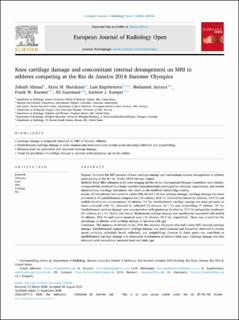| dc.description.abstract | Purpose: To report the MRI patterns of knee cartilage damage and concomitant internal derangement in athletes participating at the Rio de Janeiro 2016 Olympic Games.
Methods: Knee MRIs obtained at the core imaging facility of the International Olympic Committee were blindly, retrospectively reviewed by a board-certified musculoskeletal radiologist for meniscal, ligamentous, and tendon abnormalities. Cartilage assessment was based on the modified Outerbridge criteria.
Results: Of 122 athletes who received a knee MRI, 64 (52.4 %) had cartilage damage. Cartilage damage was more prevalent in the patellofemoral compartment (52 athletes, 42.6 %), followed by lateral (23 athletes, 18.9 %) and medial tibiofemoral compartments (12 athletes, 9.8 %). Patellofemoral cartilage damage was most prevalent in beach-volleyball (100 %), followed by volleyball (8 athletes, 66.7 %) and weightlifting (7 athletes, 70 %). Patellofemoral cartilage damage was most prevalent with quadriceps (8 athletes, 72.7 %) and patellar tendinosis (11 athletes, 61.1 %). Medial and lateral tibiofemoral cartilage damage was significantly associated with medial (8 athletes, 29.6 %) and lateral meniscal tears (16 athletes, 55.2 %), respectively. There was a trend for the percentage of athletes with cartilage damage to increase with age.
Conclusion: The majority of athletes at the 2016 Rio Summer Olympics who had a knee MRI showed cartilage damage. Patellofemoral compartment cartilage damage was most common and frequently observed in certain sports including volleyball, beach volleyball, and weightlifting. Overuse in these sports can contribute to patellofemoral cartilage damage and subsequent development of anterior knee pain. Cartilage damage was also observed with concomitant meniscal tears and older age. | en_US |
